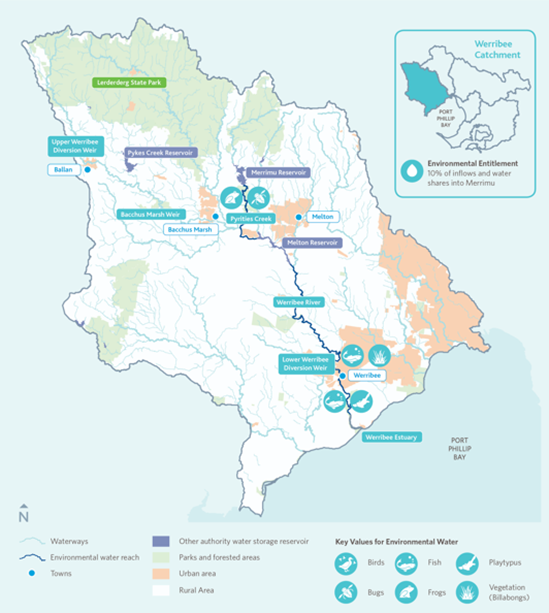Harnessing alternative water for environmental benefit
Greater Western Water and Melbourne Water are exploring an innovative approach to improving the health of the Werribee river as urban growth continues in the west.
The Werribee River relies on the release of environmental flows to maintain riparian vegetation and healthy populations of platypus, frogs, waterbugs and fish. The Werribee River catchment in the west of Melbourne is naturally drier than other parts of Melbourne and is forecast to become drier as the impacts of climate change emerge. Additional environmental flows are needed into the future to maintain and improve the health of the Werribee River.
The rapid growth in the Werribee river catchment is leading to significant volumes of alternative water in stormwater and recycled water being generated. Where possible, the use of this alternative water is being explored to replace demands for irrigation and other uses that extract water from the river to enable more river water to be used for environmental flows.
In addition, there is the potential to use the alternative water to directly meet environmental flows in the Werribee River. To provide a benefit to the environment, the alternative water needs to meet the required water-quality and flow specifications. Options for treating and storing stormwater and recycled water are being explored to determine if alternative water can meet these requirements to be used as environmental flows. If suitable, there will be sufficient volumes of alternative water available to meet key environmental flow needs for the Werribee River.
As well as improving the Environment and health of the Werribee River this initiative can also deliver the following benefits for the region:
- Traditional Owners – environmental flow releases may also enhance Traditional Owner values,
- Liveability – improved amenity and recreational use of the Werribee River,
- Affordability – cost effective management and use of stormwater and recycled water,
- Resource recovery – reuse of alternative water sources which are traditionally seen as a waste,
This project is Action 7 in the Werribee Integrated Water Management Forum’s Strategic Directions Statement.
Themes and Local Areas
| Primary Theme: | Water Supply and Use |
| Other Themes: | Waterways, Marine Environments, Traditional Owners and Aboriginal Victorians, Communities, Climate Change |
| Primary Local Area: | Moorabool, Melton, Wyndham & Greater Geelong |
| Other Local Areas: | |
| Project location: | Werribee River |
| Scale of the project: | Landscape |
| New or continuing work: | Building on previous work |
Project partners
| Lead organisation: | Greater Western Water |
| Key partners: | Department of Energy, Environment and Climate Action (DEECA), Melbourne Water |
| Registered Aboriginal Party/s relevant to the project or its area: | Bunurong Land Council Aboriginal Corporation, Wurundjeri Woi-wurrung Cultural Heritage Aboriginal Corporation, Wadawurrung Traditional Owners Aboriginal Corporation |
Investment opportunities
| Opportunities for investors within this project start from: | $$ (Tens of thousands of dollars) |
| Estimated scale of investment for full project implementation: | $$$$ (Millions of dollars) |
| Estimated timeframe for full project implementation: | 2-10 years |
Contribution toward targets
| Primary Regional Catchment Strategy target: | 1.1 Water supply and use – Adequate and stable water supplies have been secured for households, businesses, farms, Traditional Owners and the environment. Various water supply options have been effectively harnessed including stormwater harvesting, manufactured water and recycled water use. Water is shared, distributed and used efficiently by all users. |
| Relevant Biodiversity 2037 goal: | – |
| Relevant National Landcare Program priority: | – |
More information
This work is part of the program being coordinated by the Werribee Integrated Water Management Forum. https://www.water.vic.gov.au/liveable/integrated-water-management-program/forums



